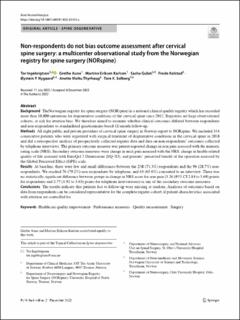| dc.contributor.author | Ingebrigtsen, Tor | |
| dc.contributor.author | Aune, Grethe | |
| dc.contributor.author | Karlsen, Martine Eriksen | |
| dc.contributor.author | Gulati, Sasha | |
| dc.contributor.author | Kolstad, Frode | |
| dc.contributor.author | Nygaard, Øystein Petter | |
| dc.contributor.author | Thyrhaug, Anette Moltu | |
| dc.contributor.author | Solberg, Tore | |
| dc.date.accessioned | 2023-01-16T12:17:05Z | |
| dc.date.available | 2023-01-16T12:17:05Z | |
| dc.date.created | 2023-01-09T09:13:22Z | |
| dc.date.issued | 2022 | |
| dc.identifier.citation | Acta Neurochirurgica. 2022, . | en_US |
| dc.identifier.issn | 0001-6268 | |
| dc.identifier.uri | https://hdl.handle.net/11250/3043708 | |
| dc.description.abstract | Background
The Norwegian registry for spine surgery (NORspine) is a national clinical quality registry which has recorded more than 10,000 operations for degenerative conditions of the cervical spine since 2012. Registries are large observational cohorts, at risk for attrition bias. We therefore aimed to examine whether clinical outcomes differed between respondents and non-respondents to standardized questionnaire-based 12-month follow-up.
Methods
All eight public and private providers of cervical spine surgery in Norway report to NORspine. We included 334 consecutive patients who were registered with surgical treatment of degenerative conditions in the cervical spine in 2018 and did a retrospective analysis of prospectively collected register data and data on non-respondents’ outcomes collected by telephone interviews. The primary outcome measure was patient-reported change in arm pain assessed with the numeric rating scale (NRS). Secondary outcome measures were change in neck pain assessed with the NRS, change in health-related quality of life assessed with EuroQol 5 Dimensions (EQ-5D), and patients’ perceived benefit of the operation assessed by the Global Perceived Effect (GPE) scale.
Results
At baseline, there were few and small differences between the 238 (71.3%) respondents and the 96 (28.7%) non-respondents. We reached 76 (79.2%) non-respondents by telephone, and 63 (65.6%) consented to an interview. There was no statistically significant difference between groups in change in NRS score for arm pain (3.26 (95% CI 2.84 to 3.69) points for respondents and 2.77 (1.92 to 3.63) points for telephone interviewees) or any of the secondary outcome measures.
Conclusions
The results indicate that patients lost to follow-up were missing at random. Analyses of outcomes based on data from respondents can be considered representative for the complete register cohort, if patient characteristics associated with attrition are controlled for. | en_US |
| dc.language.iso | eng | en_US |
| dc.publisher | Springer Nature | en_US |
| dc.rights | Navngivelse 4.0 Internasjonal | * |
| dc.rights.uri | http://creativecommons.org/licenses/by/4.0/deed.no | * |
| dc.title | Non-respondents do not bias outcome assessment after cervical spine surgery: a multicenter observational study from the Norwegian registry for spine surgery (NORspine) | en_US |
| dc.title.alternative | Non-respondents do not bias outcome assessment after cervical spine surgery: a multicenter observational study from the Norwegian registry for spine surgery (NORspine) | en_US |
| dc.type | Peer reviewed | en_US |
| dc.type | Journal article | en_US |
| dc.description.version | publishedVersion | en_US |
| dc.source.pagenumber | 0 | en_US |
| dc.source.volume | 165 | en_US |
| dc.source.journal | Acta Neurochirurgica | en_US |
| dc.identifier.doi | 10.1007/s00701-022-05453-x | |
| dc.identifier.cristin | 2102927 | |
| cristin.ispublished | true | |
| cristin.fulltext | original | |
| cristin.qualitycode | 1 | |

